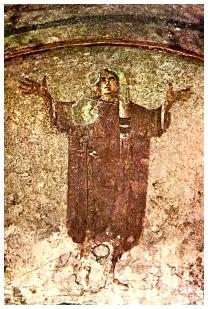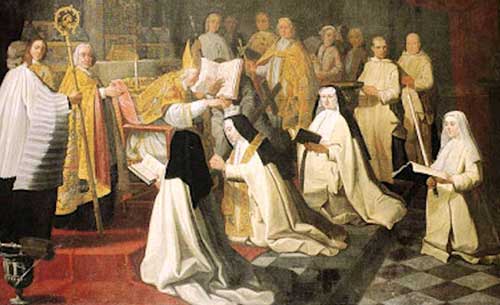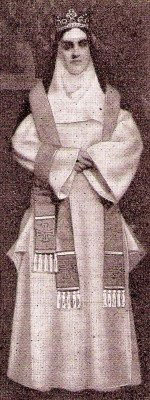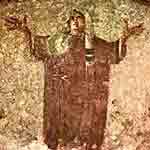
Deacons likewise must be serious, not double-tongued, not indulging in much wine, not greedy for money; they must hold fast to the mystery of the faith with a clear conscience. And let them first be tested; then, if they prove themselves blameless, let them serve as deacons. Women likewise must be serious, not slanderers, but temperate, faithful in all things. Let deacons be married only once, and let them manage their children and their households well; for those who serve well as deacons gain a good standing for themselves and great boldness in the faith that is in Christ Jesus.
1 Tim 3:8-13
There are no plans to restore the diaconate for women in the Roman Catholic Church. The commission set up by Pope Francis to explore women in the diaconate has come up with a variety of positions and no unanimous agreement. Anyone who expected this commission to have come up with a unanimous position on this would be naive – the only question was what was Pope Francis going to do with the commission’s report [cf. what Pope Paul VI did with the commission’s report on contraception].
Although in the minds of many it may do so, in Roman Catholic theology, restoring the diaconate for women does not lead to a “slippery slope” to women in the priesthood and episcopate. Although the word “ordination” is used for both, there is a distinction between the diaconate (on the one hand) and priests and bishops (on the other).
Catholic doctrine, expressed in the liturgy, the Magisterium, and the constant practice of the Church, recognizes that there are two degrees of ministerial participation in the priesthood of Christ: the episcopacy and the presbyterate . The diaconate is intended to help and serve them. For this reason the term sacerdos in current usage denotes bishops and priests but not deacons. Yet Catholic doctrine teaches that the degrees of priestly participation (episcopate and presbyterate) and the degree of service (diaconate) are all three conferred by a sacramental act called “ordination,” that is, by the sacrament of Holy Orders
Catechism of the Catholic Church 1554
In other words, priests are drawn from deacons in a not dissimilar manner as deacons are drawn from those confirmed. Confirming women does not mean they can go on to becoming deacons – having women deacons would not mean that women priests is the automatic next step.


I wonder if the commission’s report includes the practice of Carthusian nuns. They are consecrated by the diocesan bishop, wear the stole and maniple, and read the Gospel.
Within (and beyond) this discussion, there are people who use terms such as “Transitional deacon” and “Permanent deacon”. I think such terms confuse. There is no difference between the rite that ordains a “Transitional deacon” and a “Permanent deacon”. A “Transitional deacon” might not transition to priesthood, while a “Permanent deacon” might go on to become a priest. The same for priests: I am not a “Transitional priest”, nor am I a “Permanent priest”. Yes – if the Roman Catholic Church decides to ordain women as deacons but not as priests, they would actually be permanent deacons.
After Vatican II, the renewal and restoration of the diaconate as more than simply a stepping stone to priesthood was driven in part by lay men leading in the ministries which tradition would have assigned to deacons:
Although some functions of the deacons, especially in missionary countries, are in fact accustomed to be entrusted to lay men it is nevertheless “beneficial that those who perform a truly diaconal ministry be strengthened by the imposition of hands, a tradition going back to the Apostles, and be more closely joined to the altar so that they may more effectively carry out their ministry through the sacramental grace of the diaconate.”
SACRUM DIACONATUS ORDINEM
This puts into effect the call of Vatican II
Where episcopal conferences deem it opportune, the order of the diaconate should be restored as a permanent state of life according to the norms of the Constitution “De Ecclesia.” For there are men who actually carry out the functions of the deacon’s office, either preaching the word of God as catechists, or presiding over scattered Christian communities in the name of the pastor and the bishop, or practicing charity in social or relief work. It is only right to strengthen them by the imposition of hands which has come down from the Apostles, and to bind them more closely to the altar, that they may carry out their ministry more effectively because of the sacramental grace of the diaconate.
AD GENTES 16
The argument is strong that there are lay women also already involved in such leadership and service, and that “It is only right to strengthen them by the imposition of hands which has come down from the Apostles, and to bind them more closely to the altar, that they may carry out their ministry more effectively because of the sacramental grace of the diaconate.”
In fact, there are places which are reticent about ordaining Roman Catholic married men to the diaconate precisely because it can clericalise such service and leadership and also make a distinction between men giving such leadership and service and women giving identical leadership and service.
For further exploration, a good website with history and ordination rites is Women Deacons.
Further articles can be found here.
A starting discussion around the text that begins this post can be found here.
If you appreciated this post, consider liking the liturgy facebook page, using the RSS feed, and/or signing up for a not-very-often email, …
Instagram’s @liturgy is the new venture – if you are on Instagram, please follow @liturgy.



